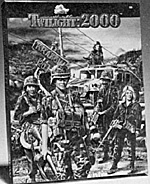 Designed by Frank Chadwick
Designed by Frank Chadwick
Game Designers' Workshop PO. Box 1646, Bloomington, IL 61720-1646
Released; December, 1984
Catalog No.: 500
Price: $16.00
Complexity: Intermediate
Solitaire Suitability: Low
Twilight: 2000 is the new role-playing game from Game Designers' Workshop (GDW). Set in the year 2000, it is a "during-the-holocaust" game. World War III started in 1995, not too many nukes were used, and your player character is in the U.S. Army in Europe. Those armies still in the field regard a division of 2,000 men and 40 tanks as full-strength. Cavalry rides horses these days, and the infantry has learned to march again.
You see, after the strategic nukes, hi-tech means electricity or the ability to reload empty cartridges. Manufacturing is on a level of the year 1900. In central Poland, your division has just been overrun, and the last word from division headquarters, "Good luck, you're on your own."
The world GDW postulates is very similar to Germany in the Thirty Years War, a land sticken by disease, famine, and bloodshed. Many units have abandoned all pretense of obeying orders and are only, concerned with feeding their own troops and getting home. Others have broken down into bands of deserters, bandits, and packs of human wolves who take what they want at the point of a gun.
Other than the somber theme, this game has a lot of appeal. Like Traveller, it doesn't pay to get into firefights. You need to use your brains to survive. There is no advanced science (or powerful magic) to heal your characters who are wounded, or even modern antibiotics. In this game a character who is shot in the torso is probably out of action for weeks at best. Since all vehicles have been converted to run on alcohol, which gives about 1/4 the mileage gasoline used to, you must stop and distill more fuel all the time. This takes several days and a fire, making it difficult to hide. It's much faster to trade with the civilians to get fuel, but how do you tell honest merchants from bandit decoys? Characters have much portable wealth in the form of military weapons, working vehicles, tools, clothing, ammo, but as modern gypsies living out of two or three trucks, they are vulnerable to ambush by people who need a ride.
Twilight: 2000 comes with a players' manual of 24 pages which covers character generation, how to use skills, combat, and maintenance of both people and equipment; a referee's manual of 32 pages with more on skills and combat, radiation, disease, encounters, trade, an official history, all about Poland, player charts, referee charts, equipment lists, and a complete introductory adventure; and dice (4d6,1d10). The box art on this game is striking, a color picture on the cover of five Americans standing before their HMMU armored vehicle, looking over a desolate landscape under gathering clouds. The signpost in the background says, "KRAKOW 20km."
Like most GDW products, the graphics here are very nice, with excellent artwork by Steve Venters. The organization of the rules requires a thorough reading followed by a period of digestion. We have had difficulty finding relevant charts as quickly as we would like. The copy we played showed some signs of being rushed into print, with some points obscured, and others just plain overlooked. I am told by Chadwick that a current errata sheet which addresses these points is available for a S.A.S.E.
Perhaps the most interesting aspect of the rules is the combat resolution. in all cases, small arms vs. people, rockets vs. tanks, thrown rocks, arrows, axe handles, whatever, all are covered with three die rolls. These determine: 1) Did it hit? 2) Where did it hit? 3) How bad? Also praiseworthy in the combat system is the Coolness Under Fire rating. This number reflects how much of each turn you spend hesitating (that is, not firing, not reloading, not throwing the grenade, etc.).
Character generation is based on die rolls, but you can increase some characteristics in exchange for decreasing others (i.e., decrease Constitution to increase Intelligence). Once the rolls are done, you buy skills with skill points based in part on your characteristics. As, the skills are what will keep you alive, I feel this is a very fair system for character creation. I would particularly like to praise the character generation worksheet, a different form than the player character record sheet, because it is so useful. Once a player has rolled up one character, he will know the system well enough to roll subsequent characters using only the worksheet and the player charts. He will not need to look at the players' manual. This is a model for how the paperwork should work in a role-playing game.
As this is a verv militarv oriented role-playing game, we find it appeals well to war gamers, as well as after-the-holocaust or science fiction huffs. Squad Leader fans will love it, but they will also get into too many firefights and die young. Beginners to role-playing should look elsewhere, because of the comparative complexity of the rules, but wargamers with no role-playing experience will do well to start with this instead of a fantasy rolegame.
More Reviews
-
Game Review: Twilight 2000: Post-Holocaust RPG
Game Review: Car Wars: Vehicle Guide, Expansion No. 6
Game Review: The Songsmith (Chivalry and Sorcery module)
Game Review: Star Ace RPG
Game Review: Heroes Unlimited (Superhero RPG)
Game Review: Isle of the Dead (Chill adventure)
Game Review: Battledroids
Game Review: Rommel in the Desert
Game Review: Broadsides and Boarding Parties
Game Review: Trax
Game Review: Empire Builder, British Rails
Game Review: The Uultimate Game
Game Review: Sologames
Back to Table of Contents -- Game News #2
To Game News List of Issues
To MagWeb Master Magazine List
© Copyright 1999 by Dana Lombardy.
This article appears in MagWeb (Magazine Web) on the Internet World Wide Web.
Other military history articles and gaming articles are available at http://www.magweb.com